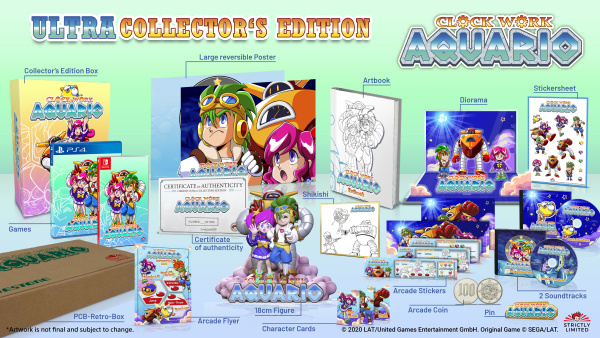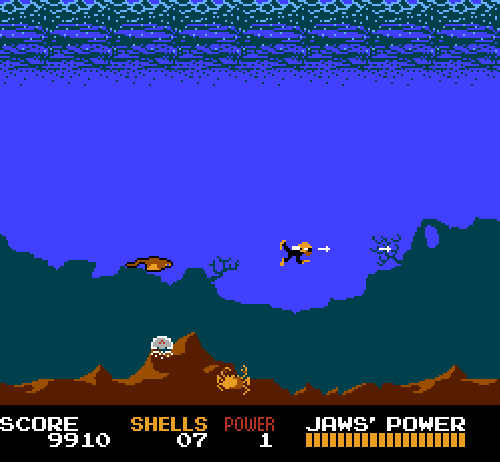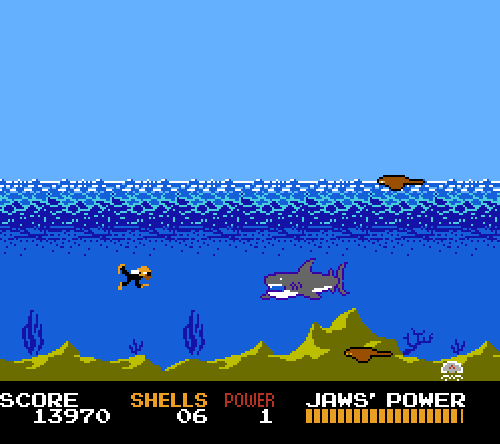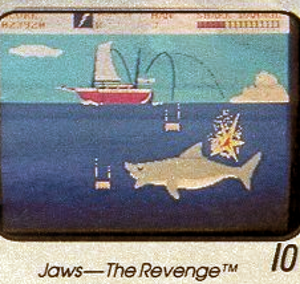Last month I discussed and possibly even lionized
Clockwork Aquario, the adorable arcade action game resurrected over two decades after Westone reluctantly canceled it. I’m glad to see that
Strictly Limited Games has made good on their promises of reissuing the game, and they’re offering
Clockwork Aquario as a basic Switch or PlayStation 4 release, an elaborate special edition, or an Ultra collector’s edition with every kind of bonus trinket short of a Huck Londo punching puppet.

All of the editions seem to be selling fast. That might not bode well for casual buyers, but it’s comforting to think that so many people care about this lost little arcade adventure from 1993—or at least that the scalpers who make up a good chunk of the limited-edition customer base assume that so many people would care.
Seeing a Westone creation so elaborately revived puts me in mind of another game from the now-defunct developer’s catalog: Jaws.
Jaws for the NES is sometimes labeled Jaws: The Revenge by mistake, and at other times it’s lumped in with some of the worst things on the system. That’s also a mistake. Jaws isn’t a defining moment in Westone history, but under the right circumstances it’s an interesting game.

Publisher LJN played it vague with the movie connection, though the game lands closest to the most recent
Jaws: The Revenge. The player sails a small map, going between two ports and spearing sea creatures in random encounters. Jaws looms near all the while, and once you’ve upgraded your power levels and gained a mini-sub, you can damage the giant shark enough to bring about a first-person duel wherein you must spear Jaws with the prow of the boat. That at least is straight from
Jaws: The Revenge, though there’s no sign of Mario Van Peebles inexplicably surviving a shark attack, Michael Caine collecting a paycheck, or the creature itself violating all known shark biology by
roaring.
In fact, Jaws is more intriguing if you take it as a completely original game. With no storyline or initial directions to introduce things, you’re left to infer that your scuba-outfitted character is an instantaneously loathsome psychopath.
That’s the most logical conclusion once you’ve played a few single-screen encounters where your avatar shoots down seemingly innocent jellyfish and stingrays, grabbing the shells and crabs they leave behind. Some of these hunts lead to bonus rounds where the player drops bombs on flocks of jellyfish, offering neither a sporting chance nor the option to grab any resulting power-ups. You, the protagonist, are just doing this because you hate nature and want to murder every animal you see.

Your relentless slaughter of the local stingrays and jellyfish summons Jaws like a guardian deity of the ocean. Apparently having forged a cartilaginous defense pact with the stingrays, the shark pops up on the overhead map and, once engaged, swims back and forth across the screen. It’s very difficult to rack up any damage at first, so you’re best off avoiding the beast until the game spits you back out onto the main map. Smaller sharks appear, though, and of course you can kill them.
Jaws has one good surprise for the first-time player. You can enter a seemingly normal hunting foray, ready to slay conventional enemies, and then see the titanic shark appear all of a sudden.

It’s unfortunate that this reveals the biggest problem with
Jaws for the NES: it needed a bigger shark. Westone had the makings of a terrifying predicament with a lone diver in the blue expanse of the undersea, knowing that an enormous predator encroaches but not quite from where. The visual impact is lost, however, when Jaws isn’t much larger than the more humdrum sharks that regularly attack the player.
Jaws is a fairly impressive game when one considers that Westone made it in only a month, and yet it flubs the most important park of any movie, book, or video game about giant sharks. They need to be scary.
And buyers might have expected an impressive, screen-filling shark thanks to promises made by LJN and the Sears Wish Book. The 1988 edition of the catalog, a staple of any child’s holiday fantasies, has a spread of NES games with mostly accurate screenshots. Bionic Commando’s spot uses an image from the arcade game, and The Karate Kid and Jaws, both LJN releases, go to greater lengths to illustrate their gameplay.
 The Karate Kid
The Karate Kid merely has larger and more fluid characters than the actual game, but
Jaws presents a shark filling a quarter of the screen while a boat pelts the beast with depth charges or perhaps giant bricks of tofu. Anyone familiar with the NES would recognize this as a mock-up, lacking the pixel look of an actual game. However, children of 1987 weren’t so versed in the technical limitations of the console, and some of them were stuck playing
Jaws and wondering when the actual titular giant shark would appear.
Sears also dubbed the game Jaws: The Revenge instead of just Jaws, suggesting either a mistake or an early title that was shortened. It might’ve been due to the critical savaging that Jaws: The Revenge endured, or perhaps some more arcane movie-rights agreement blocked off LJN. Compared to NES owners expecting a bigger shark, far fewer players were disappointed that the game didn’t have cutscenes detailing the shark’s improbable quest for revenge on a family it had no way of knowing.
False advertising and all, it’s good that Jaws existed on the NES, and perhaps it’s appropriate that Clockwork Aquario shows motifs of crabs and fishlike enemies. Just as Jaws: The Revenge paid for Michael Caine’s house, the NES game paid for Westone’s upkeep in some way. Without Jaws and other potboiler projects, Westone might not have stayed around to make Wonder Boys, Monster Worlds, and a certain arcade game that waited 27 years to reveal itself.






No comments:
Post a Comment